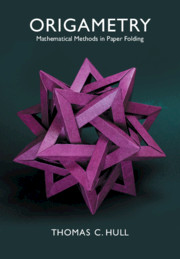Book contents
- Frontmatter
- Dedication
- Contents
- Introduction
- Part I Geometric Constructions
- Part II The Combinatorial Geometry of Flat Origami
- 5 Flat Vertex Folds: Local Properties
- 6 Multiple-Vertex Flat Folds: Global Properties
- 7 Counting Flat Folds
- 8 Other Flat-Folding Problems
- Part III Algebra, Topology, and Analysis in Origami
- Part IV Non-flat Folding
- References
- Index
7 - Counting Flat Folds
from Part II - The Combinatorial Geometry of Flat Origami
Published online by Cambridge University Press: 06 October 2020
- Frontmatter
- Dedication
- Contents
- Introduction
- Part I Geometric Constructions
- Part II The Combinatorial Geometry of Flat Origami
- 5 Flat Vertex Folds: Local Properties
- 6 Multiple-Vertex Flat Folds: Global Properties
- 7 Counting Flat Folds
- 8 Other Flat-Folding Problems
- Part III Algebra, Topology, and Analysis in Origami
- Part IV Non-flat Folding
- References
- Index
Summary
Chapter 7 delves into a handful of combinatorial problems in flat origami theory that are more general than the single-vertex problems considered in Chapter 5. First, we count the number of locally-valid mountain-valley assignments of certain origami tessellations, like the square twist and Miura-ori tessellations. Then the stamp-folding problem is discussed, where the crease pattern is a grid of squares and we want to fold them into a one-stamp pile in as many ways as possible.Then the tethered membrane model of polymer folding is considered from soft-matter physics, which translates into origami as counting the number of flat-foldable crease patterns that can be made as a subset of edges from the regular triangle lattice.Many of these problems establish connections between flat foldings and graph colorings and statistical mechanics.
Keywords
- Type
- Chapter
- Information
- OrigametryMathematical Methods in Paper Folding, pp. 137 - 158Publisher: Cambridge University PressPrint publication year: 2020

